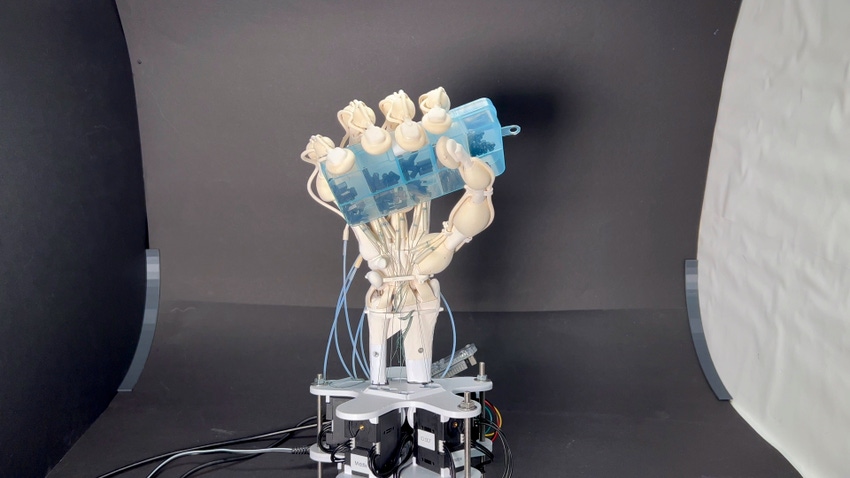3D-Printed Robotic Hand Features Bones, Ligaments, & Tendons
Different polymers were used to fabricate different aspects of the appendage.
December 5, 2023

At a Glance
- Researchers are using thiolene polymers, known for elasticity
- A 3D-printing process was adjusted to accommodate the slow-curing polymers
- Project represents another leap in soft robotics
Researchers have leveraged new 3D-printing technology to fabricate a robotic hand complete with bones, ligaments, and tendons that are all made using different polymers. The product proves a new technology for printing complex objects with different types of polymer in a single process.
A team at ETH Zurich and US-based startup Inkbit collaborated to leverage new technology that combines 3D printing with a laser scanner and a feedback mechanism. The technology allows for the printing of complex objects using a combination of soft, elastic, and rigid materials.
The new technology enabled the ETH Zurich researchers to print the robotic hand in one go, something that has never been done before, said Thomas Buchner, a doctoral student in the group of ETH Zurich robotics professor Robert Katzschmann.
“We wouldn’t have been able to make this hand with the fast-curing polyacrylates we’ve been using in 3D printing so far,” he explained. “We’re now using slow-curing thiolene polymers [with] very good elastic properties, [which] return to their original state much faster after bending than polyacrylates.”
Slowing Down
Previously, 3D-printed technology was limited to fast-curing plastics. But now scientists are finding use for slow-curing polymers such as thiolene polymers—which have enhanced elastic properties and thus are suited to printing ligaments for the hand, for example—in the 3D fabrication process.
Thiolene polymers have other durability advantages as well, and their stiffness can be fine-tuned to meet other requirements of soft robots, the researchers said.
“Robots made of soft materials, such as the hand we developed, have advantages over conventional robots made of metal," Katzschmann explained. "Because they’re soft, there is less risk of injury when they work with humans, and they are better suited to handling fragile goods."
3D printers typically produce objects layer by layer using nozzles that deposit a viscous form of a material at each point, which is then cured immediately by a UV lamp. In this method, a device scrapes any excess material that could form an irregularity in the finished product off the surface after each step.
Modifying the 3D-Printing Process
However, this process does not work with slow-curing polymers such as thiolenes and epoxies, which would clog the scraper and ruin the process. This aspect required a change in the process, which is where the work of Inkbit—a spinoff company from MIT—plays a key role in the research. The company developed a new process that includes a 3D laser scanner that immediately checks each printed layer for any surface irregularities.
“A feedback mechanism compensates for these irregularities when printing the next layer by calculating any necessary adjustments to the amount of material to be printed in real time and with pinpoint accuracy,” explained Wojciech Matusik, an MIT professor. Instead of smoothing out uneven layers, the new technology takes any irregularity into account when printing the next layer, he said.
The researchers jointly published a paper on their work in the journal Nature. The ETH Zurich team plans to explore the technology further to design even more sophisticated structures and additional applications, while Inkbit is using the technology to offer a 3D-printing service to its customers and to sell the new printers.
About the Author(s)
You May Also Like



